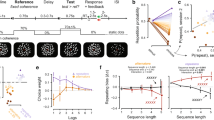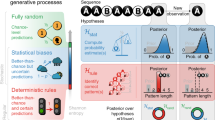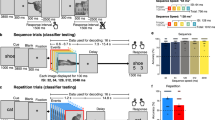Abstract
We demonstrate that regions within human prefrontal cortex develop moment-to-moment models for patterns of events occurring in the sensory environment. Subjects viewed a random binary sequence of images, each presented singly and each requiring a different button press response. Patterns occurred by chance within the presented series of images. Using functional magnetic resonance imaging (fMRI), we identified activity evoked by viewing a stimulus that interrupted a pattern. Prefrontal activation was evoked by violations of both repeating and alternating patterns, and the amplitude of this activation increased with increasing pattern length. Violations of repeating patterns, but not of alternating patterns, activated the basal ganglia.
This is a preview of subscription content, access via your institution
Access options
Subscribe to this journal
Receive 12 print issues and online access
$209.00 per year
only $17.42 per issue
Buy this article
- Purchase on Springer Link
- Instant access to full article PDF
Prices may be subject to local taxes which are calculated during checkout





Similar content being viewed by others
References
Canfield, R. L. & Haith, M. M. Young infants' visual expectations for symmetric and asymmetric stimulus sequences. Dev. Psychol. 27, 198–208 (1991).
Cohen, A., Ivry, R. I. & Keele, S. W. Attention and structure in sequence learning. J. Exp. Psychol. Learn. Mem. Cogn. 16, 17–30 (1990).
Curran, T. & Keele, S. W. Attentional and nonattentional forms of sequence learning. J. Exp. Psychol. Learn. Mem. Cogn. 19, 189–202 (1993).
Willingham, D. B., Nissen, M. J. & Bullemer, P. On the development of procedural knowledge. J. Exp. Psychol. Learn. Mem. Cogn. 15, 1047–1060 (1989).
Nissen, M. J. & Bullemer, P. Attentional requirements of learning: evidence from performance measures. Cognit. Psychol. 19, 1–32 (1987).
Tversky, A. & Kahneman, D. Judgment under uncertainty: heuristics and biases. Science 185, 1124–1131 (1985).
Hardoon, K. K., Baboushkin, H. R., Derevensky, J. L. & Gupta, R. Underlying cognitions in the selection of lottery tickets. J. Clin. Psychol. 57, 749–763 (2001).
Squires, N., Squires, K. & Hillyard, S. A. Two varieties of long-latency positive waves evoked by unpredictable auditory stimuli in man. Electroencephalogr. Clin. Neurophysiol. 38 (1975).
Courchesne, E., Hillyard, S. A. & Galambos, R. Stimulus novelty, task relevance, and the visual evoked potential in man. Electroencephalogr. Clin. Neurophysiol. 39, 131–143 (1975).
Baudena, P., Halgren, E., Heit, G. & Clarke, J. M. Intracerebral potentials to rare target and distractor auditory and visual stimuli. III. Frontal cortex. Electroencephalogr. Clin. Neurophysiol. 94, 251–264 (1995).
McCarthy, G., Luby, M., Gore, J. & Goldman-Rakic, P. Infrequent events transiently activate human prefrontal and parietal cortex as measured by functional MRI. J. Neurophysiol. 77, 1630–1634 (1997).
Kirino, E., Belger, A., Goldman-Rakic, P. & McCarthy, G. Prefrontal activation evoked by infrequent target and novel stimuli in a visual target detection task: an event-related functional magnetic resonance imaging study. J. Neurosci. 20, 6612–6618 (2000).
Alain, C., Woods, D. L. & Knight, R. T. A distributed cortical network for auditory sensory memory in humans. Brain Res. 812, 23–37 (1998).
Huettel, S. A. & Lockhead, G. R. Range effects of an irrelevant dimension on classification. Percept. Psychophys. 61, 1624–1646 (1999).
Hyman, R. Stimulus information as a determinant of reaction time. J. Exp. Psychol. 45, 188–196 (1953).
Bertelson, P. Sequential redundancy and speed in a serial two-choice responding task. Q. J. Exp. Psychol. 13, 90–102 (1961).
Holland, M. K. & Lockhead, G. R. Sequential effects in absolute judgments of loudness. Percept. Psychophys. 3, 409–414 (1968).
Schvaneveldt, R. W. & Chase, W. G. Sequential effects in choice reaction time. J. Exp. Psychol. 80, 1–8 (1969).
Levy, R., Friedman, H. R., Davachi, L. & Goldman-Rakic, P. S. Differential activation of the caudate nucleus in primates performing spatial and nonspatial working memory tasks. J. Neurosci. 17, 3870–3882 (1997).
Selemon, L. D. & Goldman-Rakic, P. S. Common cortical and subcortical targets of the dorsolateral prefrontal and posterior parietal cortices in the rhesus monkey: evidence for a distributed neural network subserving spatially guided behavior. J. Neurosci. 8, 4049–4068 (1988).
Stevens, A. A., Skudlarski, P., Gatenby, J. C. & Gore, J. C. Event-related fMRI of auditory and visual oddball tasks. Magn. Reson. Imaging 18, 495–502 (2000).
Clark, V. P., Fannon, S., Lai, S., Benson, R. & Bauer, L. Responses to rare visual target and distractor stimuli using event-related fMRI. J. Neurophysiol. 83, 3133–3139 (2000).
Sohn, M., Ursu, S., Anderson, J. R., Stenger, V. A. & Carter, C. S. The role of prefrontal cortex and posterior parietal cortex in task switching. Proc. Natl. Acad. Sci. USA 97, 13448–1453 (2000).
MacDonald, A. W., Cohen, J. D., Stenger, V. A. & Carter, C. S. Dissociating the role of the dorsolateral prefrontal and anterior cingulate cortex in cognitive control. Science 288, 1835–1838 (2000).
Braver, T. S. et al. A parametric study of prefrontal cortex involvement in human working memory. NeuroImage 5, 49–62 (1997).
Cohen, J. D. et al. Temporal dynamics of brain activation during a working memory task. Nature 386, 604–608 (1997).
Harrington, D. L. et al. Specialized neural systems underlying representations of sequential movements. J. Cogn. Neurosci. 12, 56–77 (2000).
Grafton, S. T., Fagg, A. H. & Arbib, M. A. Dorsal premotor cortex and conditional movement selection: a PET functional mapping study. J. Neurophysiol. 79, 1092–1097 (1998).
Katayama, J. & Polich, J. Stimulus context determines P3a and P3b. Psychophysiology 35, 23–33 (1998).
Comerchero, M. D. & Polich, J. P3a, perceptual distinctiveness, and stimulus modality. Cognit. Brain Res. 7, 41–48 (1998).
Zatorre, R. J., Evans, A. C., Meyer, E. & Gjedde, A. Lateralization of phonetic and pitch discrimination in speech processing. Science 256, 846–849 (1992).
Tervaniemi, M. et al. Lateralized automatic auditory processing of phonetic versus musical information: a PET study. Hum. Brain Mapp. 10, 74–79 (2000).
Middleton, F. A. & Strick, P. L. Basal ganglia and cerebellar loops: motor and cognitive circuits. Brain Res. Rev. 31, 236–250 (2000).
Gray, J. A. in The Cognitive Neurosciences (ed. Gazzaniga, M. S.) 1165–1176 (MIT Press, Cambridge, Massachusetts, 1995).
Hikosoka, O. et al. in The New Cognitive Neurosciences (ed. Gazzaniga, M. S.) 553–572 (MIT Press, Cambridge, Massachusetts, 1999).
Squires, K. C., Wickens, C., Squires, N. K. & Donchin, E. The effect of stimulus sequence on the waveform of the cortical event-related potential. Science 193, 1142–1145 (1976).
Forman, S. D. et al. Improved assessment of significant activation in functional magnetic resonance imaging (fMRI): use of a cluster-size threshold. Magn. Reson. Med. 33, 636–647 (1995).
Xiong, J., Gao, J., Lancaster, J. L. & Fox, P. T. Clustered pixels analysis for functional MRI activation studies of the human brain. Hum. Brain Mapp. 3, 287–301 (1995).
Acknowledgements
We thank C. Michelich, J. Voyvodic and J. Wu for assistance in data visualization and programming, and G. Lockhead, G. Mangun and D. Purves for comments on the manuscript. This research was supported by the US Department of Veterans' Affairs, by National Institute of Mental Health grants MH-05286 and MH-12541, and by National Institute of Neurological Disorders and Stroke grant NS-41328. G. M. is a Department of Veterans' Affairs Research Career Scientist.
Author information
Authors and Affiliations
Corresponding author
Ethics declarations
Competing interests
The authors declare no competing financial interests.
Rights and permissions
About this article
Cite this article
Huettel, S., Mack, P. & McCarthy, G. Perceiving patterns in random series: dynamic processing of sequence in prefrontal cortex. Nat Neurosci 5, 485–490 (2002). https://doi.org/10.1038/nn841
Received:
Accepted:
Published:
Issue Date:
DOI: https://doi.org/10.1038/nn841
This article is cited by
-
Rational arbitration between statistics and rules in human sequence processing
Nature Human Behaviour (2022)
-
Sex-related differences in violence exposure, neural reactivity to threat, and mental health
Neuropsychopharmacology (2022)
-
Probability matching is not the default decision making strategy in human and non-human primates
Scientific Reports (2022)
-
Cerebro-Cerebellar Response to Sequence Violation in a Cognitive Task: an fMRI Study
The Cerebellum (2022)
-
Connectivity adaptations in dopaminergic systems define the brain maturity of investors
Scientific Reports (2021)



